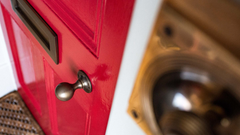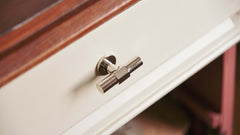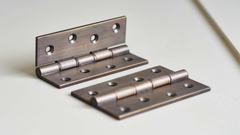Polished Chrome Vs Polished Nickel
How they’re made
Both finishes are produced in the same way – plated onto solid brass and then polished to a highly reflective, smooth, and shiny surface. Due to the solid brass beneath, these pieces won’t rust or corrode, and will last on your door for years to come.
Maintenance + Care
Both finishes are maintained in the same way, by regular polishing with a good silver polish to keep tarnishing at bay (you can read our full care guide here). Both the Nickel and Chrome finishes that we stock are unlacquered and will dull and tarnish over time if left unpolished. In terms of durability,
you may find that Chrome is slightly less susceptible to tarnishing than Nickel, although for the most part these finishes are equal in their longevity.
What’s the difference?
While they may ‘behave’ in very similar ways, the main difference between Nickel and Chrome is in their appearance – while both finishes have a silver colour, Nickel has a warmer, yellowish hue whereas Chrome is much cooler with blue undertones. This difference in shade is most striking when the two are placed side by side (as in the photo below).

For this reason, we don’t recommend mixing Chrome and Nickel in your home, as although the two may be similar, they’re quite different in proximity!
Suitability
Because of its warmth, nickel is the more ‘classic’ finish of the two, typically used in traditional settings, while chrome is at home in contemporary environments. Nickel has been used in homes since the Victorian era, whereas Chrome has had its moment more recently, in modern kitchens and bathrooms.
Because we love a timeless, traditional look here at W&S, we tend to stock Nickel over Chrome, although many of our door furniture pieces are available in Polished Chrome as well, so just email us to enquire if this is something you’re interested in.









